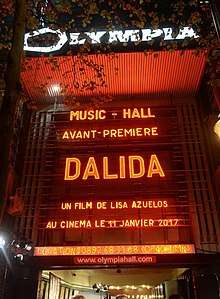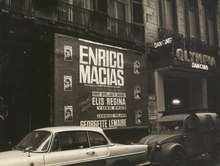Olympia (Paris)
The Olympia (French: [olɛ̃mpja]; commonly known as L'Olympia or in the English-speaking world as Olympia Hall)[2] is a concert venue in the 9th arrondissement of Paris, France, located at 28 Boulevard des Capucines, equally distancing Madeleine church and Opéra Garnier, 300 metres (980 ft) north of Vendôme square. Its closest métro/RER stations are Madeleine, Opéra, Havre – Caumartin and Auber.
 Famous red neon facade in 2016 used for Dalida film projection, first time in the history of Olympia | |
%26groups%3D_b242bfea66420dcc06b5233fa666aef4e14d4b1f.svg)
| |
| Full name | Olympia |
|---|---|
| Former names | Montagnes Russes (1889–93) Théâtre Jacques Haïk (1928–1944) |
| Address | 28 Boulevard des Capucines 75009 Paris, France |
| Location | 9th arrondissement |
| Owner | Coquatrix Family |
| Capacity | 1,985 (seated)[1] 2,824 (concert)[1] |
| Construction | |
| Opened | 26 May 1888 |
| Renovated | 1954, 1979, 1997, 2001 |
| Closed | 1916–18, 1944–54 |
| Website | |
| Venue Website (in French) | |
The hall was opened in 1888 by the co-creators of the Moulin Rouge venue, and saw many opera, ballet and music hall performances. Theatrical performances declined in the early 20th century and the Olympia was converted into a cinema, before re-opening as a venue in 1954. Since the 1960s, it has been a popular venue for rock bands. The Olympia was nearly demolished in the early 1990s, but saved by a preservation order and extensive reconstruction, and remains a popular venue.
History
Co-founded in 1888, by Joseph Oller and Charles Zidler, the co-creators of the Moulin Rouge, today the venue is easily recognized by its giant red glowing letters announcing its name. It opened in 1889 as the Montagnes Russes but was renamed the Olympia in 1893. Besides musicians, the Olympia played host to a variety of entertainment including circuses, ballets, and operettas. However, following a steady decline in appearances by the great stars, from 1929 until 1944 it served as a cinema. It may have opened as a music hall under the German occupation of France during World War II, but certainly in 1945 after the Liberation, it was a music hall free to Allied troops in uniform. Attendees had to listen to the playing of four national anthems before the varied programs that always ended with a spirited can-can dance. Thereafter, at times it may have reverted to movies again until Bruno Coquatrix revived it as a music hall with a grand re-opening in February 1954. After his death, it went into another slow decline and was in danger of being torn down and turned into a parking lot but on 7 January 1993, France's then Minister of Culture, Jack Lang issued a preservation order for the Olympia that resulted in two years of construction work to rebuild a perfect replica of the façade and the grandeur of its famous red interior.
Édith Piaf achieved great acclaim at the Olympia giving several series of recitals from January 1955 until October 1962.
Dalida was the most commercially successful solo performer at the Olympia. Her first performance in the hall was in early 1956 at auditions held by Eddie Barclay and Bruno Coquatrix. It was then when she was discovered and chosen to sign a contract. Later that year she supported Charles Aznavour for his concert. Her own first concert there was in 1959. After that she would perform in Olympia every three to four years, singing for 30 nights in row, completely sold-out in 1961, 1964, 1967, 1971, 1974, 1977, 1981. Her last Olympia appearance was in 1981, and in 1983 the hall went bankrupt. Releasing Olympia 67 after her 1967 Olympia concert, she started releasing albums named for Olympia concerts, a style followed by other singers. She continued doing that until her last concert in Olympia, Olympia 81. Olympia 71, Olympia 74, and Olympia 77 are live albums.
Before going to America, the Beatles performed eighteen days (16 January – 4 February 1964) of concerts at the Olympia Theatre, playing two and sometimes three shows a day. They were staying at the Hotel George V and after returning at the end of their first day, they were told that "I Want to Hold Your Hand" had reached number one in America. Jeff Buckley, long an admirer of Piaf, gave what he considered the finest performance of his career there in 1995, which was later released in 2001 on Live at L'Olympia. Jacques Brel's 1961 and 1964 concerts at L'Olympia are legendary and preserved to this day on new CD releases. Marlene Dietrich's 1962 Olympia concert was broadcast. On 3–4 May 1972 the Grateful Dead played two concerts here as part of their first major European tour. Both shows were recorded and songs from each were released on their 1972 live album Europe '72. Dave Gahan's performance was released on the 2004 DVD, Live Monsters.[3]
On 30 November 2017, Olympia was used for movie projection again, with the premiere of the biopic Dalida. The screening was significant in France and was broadcast live by several television stations.
Performers

Inaugurated by the biggest star in France at the time, singer/dancer La Goulue, the venue has showcased a wide variety of performers, including French acts such as Dalida, Alan Stivell, Nolwenn Leroy, Édith Piaf, Léo Ferré, Charles Aznavour, Grégory Lemarchal, Joe Dassin, Chimène Badi, Julie Pietri, Adamo, Gilbert Bécaud, Jacques Brel, Yves Montand, Johnny Hallyday, Mireille Mathieu, Barbara, Véronique Sanson, Charles Trenet, Yvonne Printemps, Michel Polnareff, and many others.
International stars have included Nana Mouskouri, Lola Beltran, Red Hot Chili Peppers, Grateful Dead, Sting, Roy Orbison, Paul Simon, Art Garfunkel, Bob Dylan, Joan Baez, Lili Ivanova, Billie Holiday, Nina Simone, The Nice, The Cure, Coldplay, Lindsey Stirling, Gloria Estefan, Lana Del Rey, Fally Ipupa, Tokio Hotel, Violetta Villas, The Beach Boys, Alla Pugacheva, The Beatles, Art Blakey and the Jazz Messengers, David Bowie, Black Sabbath, Judy Garland, Miles Davis, John Coltrane, Pink Floyd, Alice Cooper, Jimi Hendrix, Gary Moore, Umm Kulthum, Sabah, Fairouz, Majida El Roumi, Najwa Karam, Tina Turner, Madonna, Ray Charles, Janet Jackson, Björk, Garbage, Tori Amos, Abdel Halim Hafez, Elissa, Free, The Jackson 5, Jorge Ben, Maysa, Liza Minnelli, Lara Fabian, Lluís Llach, Jethro Tull, Amália Rodrigues, Iggy Pop, Led Zeppelin, Linda de Suza, Josephine Baker, Celine Dion, Cher, Diana Ross & The Supremes, Nelly Furtado, Tony Carreira, Evanescence, Arctic Monkeys, James Brown and Ahlam, Tereza Kesovija, Oliver Dragojević, Midnight Oil, The Rolling Stones, coldrain, Il Volo, Ajda Pekkan, Bülent Ersoy, Beady Eye, Olivera Katarina, Mashrou' Leila, Norah Jones, Blondie, Monsta X, Aretha Franklin, The Pogues, Julio Iglesias and Taylor Swift,[4] and Khaled.
References
- "Olympia La Salle de Spectacle". Olympiahall.com. Retrieved 2 February 2018.
- "Name of the venue". Paris tourist office. Retrieved 29 October 2018.
- "Dave Gahan To Release "Live Monsters" DVD March 1 On Mute Records"
- Mylrea, Hannah (September 10, 2019). "Taylor Swift's The City of Lover concert: a triumphant yet intimate celebration of her fans and career". NME. Retrieved September 11, 2019.
- Sources
- Jean-Michel Boris, Jean-François Brieu, Eric Didi: Olympia Bruno Coquatrix, 50 ans de Music-Hall, 2003, Editions Hors Collection, ISBN 2-258-06234-9
- Paulette Coquatrix: Mes noces d'or avec l'Olympia, Bordeaux, Le Castor Astral
- Jeanne Tallon: J’étais ouvreuse à l'Olympia, 2004, Paris, Editions Fayard, ISBN 2-213-61839-9
External links
| Wikimedia Commons has media related to Olympia (Paris). |